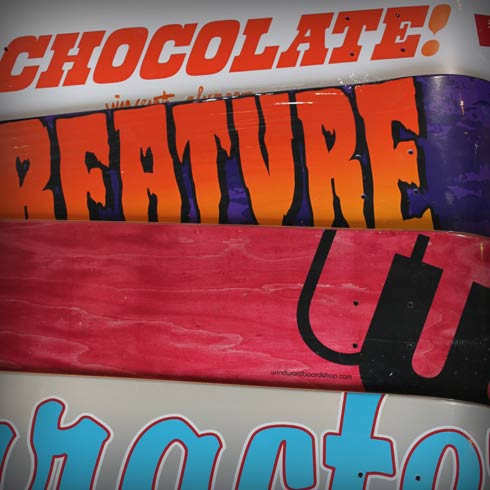Whether you are 5 or 50, if you are embarking on your first skateboard purchase this little guide will help get you on the right ride. We will help you navigate thru the different deck sizes, wheels types, trucks and what it all means for you.
deck
- All skateboard decks will all have a very similar shape but vary slightly in width.
- For the little ones, a mini is a great idea. Shaped exactly like a regular skateboard but a few inches shorter and less wide.
- Skateboards are usually 28 to 33 inches long. Under 33 would fall into the “mini” category. Mini’s are generally between 7 and 7.5 inches wide and and regular size decks start at 7.5 and go up from there.
- Anything over 9 inches wide could be classified as an old school shape.
- Personal preference definitely dictates the right size for you. If you are just starting out, you could stick with something between 7.75 and 8.25 and see what feels comfortable.
kicktail
- The nose and tail of the board have what is called a “kicktail.” This means the nose and tail are turned up slightly and can be used for a number of reasons.
- Some boards have more concave or steeper kicktails than others, it all comes down to personal preference. When you start doing tricks, these things will come into play.
trucks
- Your trucks are what hold the wheels and attach to the deck.
- Truck size should coincide with your deck size. If you sit the truck on the board, the axle length should line up with the edge of the board.
- Once you get the trucks on the board you can adjust the way they turn. By tightening or loosening the screw on the kingpin you can make turning easier or harder as desired.
bushings
- Built into the trucks, the bushings dictate how easy or hard it is to turn the board.
- Softer bushings allow for easier turnability and harder bushings give a more rigid, precise ride.
- Bushings can be changed easily so you can try different options and find what feels most comfortable.
wheels
Big ones, small ones, hard ones, soft ones.. The list goes on. When it comes to wheels, it’s all about trying everything you can until you get it right.
wheel size
- Skate wheels will start around size 49mm and go up to about 60mm, anything over 60 will likely fall into the longboard department otherwise you could be destined for wheel bite. (wheel bite is what happens when your wheel makes contact with your board. It’s like slamming on the breaks on a car, it’s a big bummer.)
- It’s a good idea to start with something middle of the road sized like a 52mm wheel and see how that feels. Generally speaking, smaller wheels are lightweight and fast and larger wheels offer a little more stability and a smoother ride.
wheel hardness
- Printed on the wheel you might see 2 different sets of numbers. One is the size of the wheel and the other is the durometer rating. For example, if the wheel says 51mm, 101A – then that means the wheel is 51mm and the hardness rating is 101A.
- Harder wheels are more responsive and softer wheels offer a smoother ride. Generally, skate wheels will fall under the 86A – 101A ratings. Longboard or ‘cruiser’ wheels will have something like an 80A rating (good for cruising but not good for tricks).
- Some wheels have what is called “dual-durometer” construction. That generally means the wheel is harder on the inside for better response and softer on the outside for a more smooth ride.
